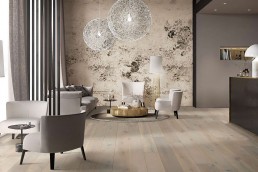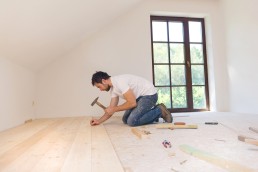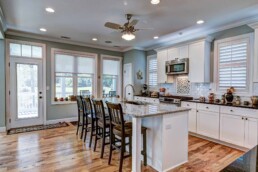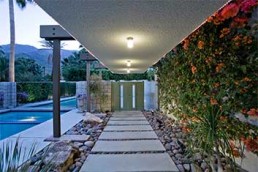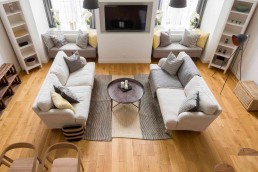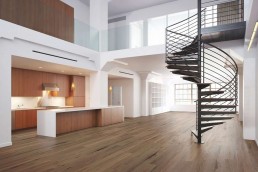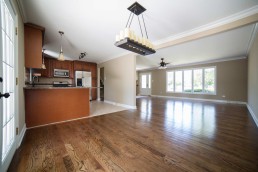Choosing The Right Finish For Hardwood Floors
Choosing the right finish for hardwood floors is a critical decision that can significantly impact the overall aesthetic and maintenance of your living space. One of the primary considerations is whether to opt for a shiny finish or a non-shiny (matte or satin) finish. In this blog, we'll explore the pros and cons of both options, helping you make an informed decision based on your preferences and lifestyle.
 Pros of Shiny Finished Hardwood:
Pros of Shiny Finished Hardwood:
1. Elegant Aesthetics:
Shiny finished hardwood floors exude a timeless and elegant appeal. The glossy surface reflects light, creating a luxurious and polished look that can enhance the overall aesthetic of your home. The shine brings out the natural beauty of the wood, showcasing its grains and patterns in a way that adds sophistication to any room.
2. Easy to Clean:
The smooth surface of shiny finished hardwood makes it relatively easy to clean and maintain. Dust and dirt are less likely to cling to the glossy surface, and spills can be wiped away effortlessly. This feature is particularly advantageous for busy households or those with children and pets, as the glossy finish resists stains more effectively than matte finishes.
3. Durability and Resistance:
Shiny finishes often include multiple layers of protective coating, enhancing the durability of the hardwood. The added layers provide resistance against scratches, scuffs, and general wear and tear. This durability ensures that the flooring maintains its glossy sheen over time, contributing to a longer lifespan for your hardwood floors.
Cons of Shiny Finished Hardwood:
1. Visible Scratches and Imperfections:
While shiny finishes offer durability, they can also be more prone to showing scratches and imperfections. The reflective surface can highlight any marks or damage, making them more noticeable. This factor might be a concern for homeowners who prioritize a flawless appearance and are wary of the visible signs of wear.
2. Maintenance Challenges:
Despite being easier to clean in some respects, shiny finishes can be more demanding when it comes to maintenance. Smudges, footprints, and water spots are more noticeable on glossy surfaces, requiring more frequent cleaning to keep the floors looking pristine. This level of maintenance might be a drawback for individuals with a hectic lifestyle.
Pros of Non-Shiny (Matte or Satin) Finished Hardwood:
1. Natural and Subtle Look:
Non-shiny finishes, such as matte or satin, offer a more natural and subtle appearance. The lack of a glossy sheen allows the true character of the wood to shine through without added reflections. This aesthetic is ideal for those who prefer a more understated and muted look in their living spaces.
2. Conceals Scratches and Imperfections:
Matte or satin finishes are excellent at concealing scratches, scuffs, and other imperfections. The lack of a reflective surface minimizes the visibility of marks, making these finishes a practical choice for homeowners who want a low-maintenance flooring option that ages gracefully.
3. Enhanced Grip and Traction:
Non-shiny finishes are often more slip-resistant than their glossy counterparts. This can be particularly advantageous in homes with children, elderly individuals, or individuals with mobility concerns. The added grip and traction contribute to a safer environment, especially in areas prone to spills or moisture.
Cons of Non-Shiny (Matte or Satin) Finished Hardwood:
1. Less Dramatic Aesthetics:
While matte or satin finishes offer a subtle and natural look, they might lack the dramatic impact and visual depth associated with shiny finishes. The absence of a glossy sheen means less light reflection, potentially resulting in a less vibrant appearance.
2. Challenges in Cleaning Stains:
Non-shiny finishes may require more effort when it comes to cleaning certain stains. Spills and marks can be absorbed by the wood more readily, making it necessary to address them promptly to avoid long-term damage. This could be a consideration for those who prefer a flooring option with minimal upkeep.
Conclusion:
Choosing between shiny and non-shiny finishes for hardwood flooring ultimately comes down to personal preferences, lifestyle, and the desired aesthetic for your home. Shiny finishes bring a touch of glamour and are easier to clean but may require more attention to maintenance. On the other hand, non-shiny finishes offer a more natural look, are forgiving of imperfections, and provide enhanced traction. Consider your priorities and lifestyle factors to determine which type of finish aligns best with your vision for a beautiful and functional living space.
The Elegant Option of Luxury Vinyl Tile Flooring
Luxury Vinyl Tile (LVT) flooring has emerged as the epitome of sophistication and practicality in the world of interior design. As homeowners increasingly seek elegance without compromising on durability, LVT has become the go-to option for flooring that seamlessly combines style and resilience. In this blog, we'll delve into the nuances of luxury vinyl tile flooring, exploring its key features, benefits, and why it stands out as an elegant option for modern living spaces.
Unveiling the Elegance of Luxury Vinyl Tile:
Luxury vinyl tiles are engineered to mimic the look and feel of natural materials, such as hardwood or stone, with a level of authenticity that is truly remarkable. The advanced printing and embossing technologies used in the manufacturing process allow LVT to replicate the intricate details of wood grains, textures, and even the subtle variations found in natural stone. This means homeowners can enjoy the luxurious aesthetics of premium materials without the associated maintenance challenges.
Endless Design Possibilities:
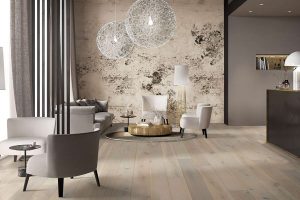
One of the standout features of luxury vinyl tile flooring is its versatility in design. Whether you prefer the classic warmth of oak, the contemporary allure of concrete, or the timeless beauty of marble, LVT offers a diverse range of design options. The ability to mix and match different patterns, colors, and sizes opens up endless possibilities for creating personalized and visually stunning flooring arrangements. This adaptability ensures that luxury vinyl tiles seamlessly integrate into any interior design concept, from traditional to modern.
Durability Beyond Compare:
Luxury vinyl tiles are engineered for durability, making them an ideal choice for high-traffic areas in residential and commercial spaces. The wear layer on top of the tiles provides resistance against scratches, stains, and dents, ensuring that the flooring maintains its pristine appearance even in the face of daily wear and tear. This resilience makes LVT a sensible investment, as it significantly extends the lifespan of the flooring compared to other materials.
Waterproof and Low Maintenance:
The elegance of luxury vinyl tiles is not only skin-deep but extends to their functional attributes. Unlike natural materials, LVT is inherently waterproof, making it an excellent choice for moisture-prone areas like kitchens and bathrooms. The waterproof nature of luxury vinyl tile flooring adds a layer of protection against spills and accidents, making it easy to clean and maintain. Regular sweeping and occasional mopping are typically all that's needed to keep LVT looking as good as new.
Comfort Underfoot:
Beyond aesthetics and durability, LVT also prioritize comfort. The soft and resilient nature of LVT provides a comfortable surface underfoot, making it an excellent choice for spaces where people stand for extended periods. Whether you're hosting a dinner party or spending time in the kitchen, the cushioned feel of luxury vinyl tile flooring enhances the overall comfort of your living spaces
Installation Ease:
Elegance meets convenience with the easy installation of luxury vinyl tiles. Many LVT products come with innovative click-lock systems that allow for straightforward and quick installation, making it a suitable choice for both DIY enthusiasts and professional installers. The hassle-free installation process adds to the overall allure of luxury vinyl tile flooring as a practical and stylish flooring solution.
Budget-Friendly Elegance:
While luxury often comes with a hefty price tag, LVT break the mold by offering an elegant flooring solution at a fraction of the cost of natural materials. This affordability makes LVT an attractive option for homeowners who seek the sophistication of high-end flooring without exceeding their budget. The cost-effectiveness of luxury vinyl tile flooring ensures that you can achieve a luxurious look without compromising on quality.
In Conclusion:
Luxury vinyl tile flooring stands out as the elegant option for those who appreciate the beauty of high-end materials but also value practicality and resilience. With its authentic aesthetics, durability, waterproof features, and ease of maintenance, LVT strikes a perfect balance between luxury and functionality. As interior design trends evolve, LVT continue to be a timeless choice that transcends fleeting fads, providing a foundation of elegance for homes and spaces that aspire to make a lasting impression.
Benefits of Luxury Vinyl Tile
Luxury Vinyl Tile (LVT) flooring has gained significant popularity in recent years, and for good reason. This innovative flooring option offers a multitude of benefits that make it an attractive choice for homeowners. From its durability to its aesthetic appeal, let's delve into the various advantages of opting for luxury vinyl tile flooring.
One of the standout features of LVT flooring is its exceptional durability. Unlike traditional vinyl flooring, luxury vinyl tiles are constructed with multiple layers that enhance their strength and resilience. This makes them well suited for high-traffic areas in homes, such as hallways, kitchens, and living rooms. The protective layers of LVT flooring ensure resistance against scratches, dents, and stains, making it an ideal choice for households with children and pets.
 Additionally, luxury vinyl tiles are known for their water-resistant properties. Unlike hardwood or some laminate options, LVT flooring can withstand moisture without warping or damage. This makes it a practical solution for spaces like bathrooms, kitchens, and basements, where spills and humidity are common. The water-resistant nature of LVT not only contributes to its longevity but also simplifies the cleaning process, making it easy to maintain its pristine appearance.
Additionally, luxury vinyl tiles are known for their water-resistant properties. Unlike hardwood or some laminate options, LVT flooring can withstand moisture without warping or damage. This makes it a practical solution for spaces like bathrooms, kitchens, and basements, where spills and humidity are common. The water-resistant nature of LVT not only contributes to its longevity but also simplifies the cleaning process, making it easy to maintain its pristine appearance.
Aesthetic versatility is another key benefit of luxury vinyl tile flooring. With advanced printing and embossing technologies, LVT can mimic the look and texture of various natural materials, including hardwood, stone, and ceramic tiles. This allows homeowners to achieve the desired aesthetic without the associated costs and maintenance challenges of authentic materials. Whether you prefer the warmth of wood or the sophistication of marble, LVT provides a wide range of design options to suit diverse interior styles.
Installation convenience is a notable advantage of luxury vinyl tiles. Many LVT products feature user-friendly installation systems, such as click-lock mechanisms, making it possible for homeowners to undertake the installation themselves. This not only saves on installation costs but also expedites the process, allowing for quicker enjoyment of the newly transformed space. Additionally, LVT can often be installed over existing flooring, reducing the need for time-consuming and costly subfloor preparations.
Comfort underfoot is an often overlooked benefit of luxury vinyl tile flooring. The flexible and resilient nature of LVT provides a comfortable surface to walk on, which is especially appreciated in areas where people tend to stand for longer periods, such as kitchens. Unlike some hard flooring materials, LVT offers a softer feel without compromising on durability, creating a comfortable and inviting environment in your home.
Maintenance simplicity is a key consideration for many homeowners, and LVT delivers on this front. Regular cleaning involves simple tasks like sweeping or vacuuming to remove debris, followed by damp mopping for a thorough clean. The protective layers of LVT make it resistant to stains and spills, further reducing the need for extensive maintenance efforts. This ease of care is particularly advantageous for busy households where time is of the essence.
Another environmental benefit of luxury vinyl tile flooring is its sustainability. Many LVT products are made using recycled materials, and the manufacturing process often involves less energy and resources compared to the production of certain natural materials. Additionally, the longevity of LVT reduces the frequency of replacements, contributing to a more sustainable and eco-friendly flooring choice.
In conclusion, luxury vinyl tile flooring stands out as a versatile and practical option for homeowners seeking a combination of durability, aesthetic appeal, and convenience. From its resistance to wear and moisture to its diverse design options, LVT offers a host of benefits that make it a compelling choice for modern living spaces. Whether you prioritize durability, style, or ease of maintenance, luxury vinyl tile flooring is a well-rounded solution that can enhance the comfort and aesthetics of your home.
Can Insects Find Haven in Your Hardwood Floors?
Hardwood flooring is a classic choice, admired for its timeless beauty and durability. However, the very features that make it an appealing flooring option may inadvertently create an environment conducive to insect infestation. In this exploration, we'll unravel the mysteries beneath the polished surface and delve into whether insects can truly find a home in your hardwood floors.
Understanding the Ideal Habitat for Insects:
Hardwood floors, crafted from natural materials, possess a unique set of characteristics that may attract insects. Cellulose, a primary component of wood, serves as a delectable feast for certain pests. Termites, renowned for their wood-munching tendencies, are particularly drawn to hardwood floors rich in cellulose fibers.
The type of wood used in your flooring can also impact its susceptibility to insect infestation. Some hardwoods are denser and less prone to pests, while others may be more inviting. Additionally, environmental factors like humidity and temperature play pivotal roles. High humidity levels can compromise the integrity of the wood, creating an environment that is not only appealing to insects but also conducive to their reproduction.
 Common Insects Found in Hardwood Floors:
Common Insects Found in Hardwood Floors:
Several insects are notorious for seeking refuge within hardwood flooring. Termites, with their insatiable appetite for cellulose, can silently wreak havoc beneath the surface. Powder post beetles, another formidable foe, can lay their eggs in the pores of hardwood, leading to structural damage over time. Identifying these potential intruders is crucial for the early detection and mitigation of infestations.
Termites, often referred to as "silent destroyers," can remain hidden for extended periods, making it imperative to recognize signs of their presence. Look out for sagging floors, hollow sounds when tapping the wood, or the discovery of discarded wings near windowsills. Powder post beetles, on the other hand, leave behind small, round exit holes and fine, flour-like powder—the telltale signs of their activity.
Signs of Infestation:
Detecting an insect infestation in your hardwood flooring requires a keen eye for subtle indicators. Pay attention to changes in the appearance of the wood, such as discoloration, warping, or the presence of tiny holes. Unusual sounds, like tapping or rustling, can also be indicative of insect activity beneath the surface. In severe cases, you may even notice a distinct odor, signaling decay caused by pests.
Regular inspections and maintenance routines are vital in identifying these signs early on. Prompt action can prevent further damage and save you from costly repairs down the line.
Prevention and Maintenance:
Proactive measures are key to safeguarding your hardwood flooring against insect infestation. Start by controlling the indoor environment—maintain optimal humidity levels and address any leaks or water damage promptly. Seal gaps and cracks in the flooring to deny pests easy access, and consider using hardwoods less attractive to insects.
Regular cleaning is another effective preventive strategy. Remove dust, debris, and potential food sources for insects, reducing the likelihood of infestation. Applying protective coatings, such as sealants or finishes, can further fortify your hardwood floors against invasive pests. Have more questions about hardwood flooring? Stop by our showroom today in Peterborough where one of our team members would be happy to answer any questions!
Mastering the Art of Luxury Vinyl Flooring Installation
Luxury vinyl flooring has become a sought-after choice for homeowners seeking a perfect blend of elegance and durability. If you're considering a DIY luxury vinyl flooring installation project, you're in the right place. In this comprehensive guide, we'll walk you through the step-by-step process, ensuring your flooring project is not only visually stunning but also long-lasting.
Preparation is Key
Before diving into the installation, meticulous preparation is essential. Gather your tools and materials, including luxury vinyl planks or tiles, adhesive, underlayment, a tape measure, a utility knife, and a straight edge. Take the time to inspect and prepare your subfloor – it should be smooth, clean, and completely dry. Any imperfections in the subfloor can affect the final result, so invest time in repairing and leveling the surface.
Luxury vinyl flooring needs time to acclimate to its new environment. Unpack the materials and allow them to sit in the installation space for at least 48 hours. This step ensures that the planks adjust to the temperature and humidity of the room, minimizing the risk of expansion or contraction after installation.
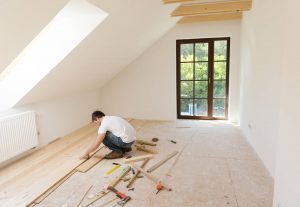 Start with a Solid Foundation:
Start with a Solid Foundation:
Establish a straight and square starting line. This line will serve as the reference point for the entire installation. Accuracy here is crucial, so take your time to measure and mark the layout.
Install the Underlayment:
The underlayment provides additional support, insulation, and noise reduction. Roll out the underlayment and trim it to fit, ensuring it covers the entire floor area. Tape seams securely to prevent any movement during installation.
Begin Laying the Luxury Vinyl Planks:
Commence the installation by laying the first row of planks along the reference line. Pay attention to the manufacturer's recommendations for staggering the seams and maintaining proper spacing between planks. This initial row sets the stage for the rest of the installation, so double-check and adjust as needed.
Continue with Subsequent Rows:
As you progress, ensure each row maintains a staggered pattern to create a visually appealing layout. Use a tapping block and rubber mallet to snugly fit the planks together. Check regularly for spacing consistency.
Cutting and Fitting:
Measure and cut planks to fit around obstacles and along walls. A utility knife and a straight edge are your best friends in achieving precise cuts. Remember to leave a small gap around the edges to accommodate potential expansion.
Dealing with Doorways and Corners:
Handling doorways and corners requires extra attention. Measure and cut planks to fit, ensuring a seamless transition between rooms. Use transition strips as needed for a polished finish.
Selecting the Right Adhesive:
Different luxury vinyl flooring products may require specific adhesives. Consult the manufacturer's guidelines to choose the adhesive that suits your flooring type.
Applying Adhesive:
Apply the adhesive according to the manufacturer's instructions. A notched trowel is commonly used for spreading adhesive evenly. Work in manageable sections to ensure the adhesive remains tacky when laying the planks.
Pressing and Rolling:
After placing each plank, press it firmly into the adhesive. Use a roller to ensure a secure bond between the luxury vinyl and the subfloor. This step is crucial for preventing any lifting or shifting over time.
Trimming and Baseboards:
Complete the installation by installing trim and baseboards. These finishing touches not only enhance the aesthetic appeal but also hide expansion gaps and create a seamless transition between the flooring and walls.
Clean-Up:
Take the time to clean up any excess adhesive promptly. A clean workspace ensures a professional finish and minimizes the need for post-installation maintenance.
Conclusion
By following these steps, you'll master the art of luxury vinyl flooring installation. This DIY project not only adds a touch of sophistication to your space but also provides a durable and low-maintenance flooring solution. Embrace the process, pay attention to detail, and revel in the satisfaction of transforming your space with the timeless beauty of luxury vinyl flooring. Stop by our showroom to checkout some of the different LVP patterns we have for your next project in Peterborough!
The hard choice between Luxury Vinyl & Hardwood Flooring
Choosing the right flooring for your home is a significant decision that involves considering various factors, especially when debating between Luxury Vinyl Plank (LVP) and Hardwood Floors. Both options have their own set of advantages and drawbacks, and understanding these factors can help you make an informed decision that aligns with your preferences, lifestyle, and budget.
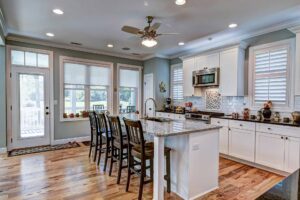
**1. Aesthetic Appeal:**
Luxury Vinyl Flooring (LVF) has made remarkable strides in mimicking the look of hardwood. The technology behind LVP allows for realistic textures and patterns that closely resemble natural wood. However, some individuals still appreciate the timeless and authentic beauty of hardwood floors. The warmth and character of real wood add a unique charm to a space that luxury vinyl might emulate but only partially replicate.
**2. Durability:**
LVP is celebrated for its durability, making it an excellent choice for high-traffic areas, families with pets, or homes with children. Luxury vinyl is resistant to scratches, stains, and moisture, providing a robust flooring option that stands up well to everyday wear and tear. On the other hand, hardwood floors, while durable, are more susceptible to scratches and can be adversely affected by moisture.
**3. Cost Considerations:**
Budget plays a crucial role in flooring decisions. Luxury vinyl flooring often comes at a lower price point than hardwood. Additionally, installation costs for LVP are generally lower, making it a more cost-effective option. Hardwood floors, while timeless and elegant, tend to have a higher upfront cost, and installation costs can vary depending on the type of wood chosen.
**4. Installation and Maintenance:**
Luxury vinyl flooring is known for its ease of installation, and many varieties come with click-and-lock systems, making it a popular choice for DIY enthusiasts. Furthermore, LVP is relatively low maintenance, requiring simple cleaning routines to keep it looking pristine. Hardwood, however, demands more attention during installation, and maintenance involves periodic refinishing and careful cleaning to preserve its natural beauty.
**5. Environmental Impact:**
Sustainability is a growing concern for many homeowners. Hardwood floors, when sourced responsibly, can be an environmentally friendly choice, especially if the wood is certified by organizations like the Forest Stewardship Council (FSC). On the other hand, luxury vinyl flooring is often made from synthetic materials, which may not be as environmentally sustainable. However, advancements in eco-friendly vinyl options are emerging, catering to those seeking a more sustainable choice.
**6. Comfort and Insulation:**
Hardwood floors have a natural warmth that adds comfort to a home. They are also conducive to underfloor heating systems. Luxury vinyl, while providing a softer surface compared to hardwood, may not have the same insulating properties. Consider the climate in your region and your preference for underfoot comfort when deciding between the two.
**7. Resale Value:**
The resale value of a home is influenced by various factors, and flooring choice is one of them. Hardwood floors are often considered a premium feature that can increase the perceived value of a property. Some potential buyers may prefer the authenticity and luxury associated with hardwood over vinyl. However, the resale value impact may vary depending on the local real estate market and buyer preferences.
**8. Moisture Resistance:**
One of the significant advantages of luxury vinyl flooring is its resistance to moisture. LVP can be installed in areas prone to high humidity, such as basements and bathrooms, where hardwood might not be a suitable option. If your home is in an environment where moisture is a concern, LVP could be the more practical choice.
9. Longevity
Hardwood floors have a long lifespan and can be refinished multiple times, allowing them to last for generations. While luxury vinyl is durable, it may not have the same longevity as hardwood. Consider your long-term plans for the property when deciding between the two.
10. Allergens and health concerns
For individuals with allergies, luxury vinyl flooring is a favorable option as it does not harbor allergens and is easy to clean. Hardwood floors, if kept clean and free of mold, can also be a suitable choice. Consider your family's health needs and whether anyone in the household has specific allergies when making your decision.
In conclusion, the choice between Luxury Vinyl Plank and Hardwood Floors depends on a multitude of factors. Assessing your priorities, budget constraints, and the specific requirements of each room in your home will guide you toward the flooring option that best suits your needs. Whether you opt for the timeless elegance of hardwood or the practicality of luxury vinyl, both choices can enhance the beauty and functionality of your living space. Contact our team to learn more about the different options that we offer in Peterborough!
Choosing the right tile flooring for your outdoor space
Choosing the right tile for your outdoor space is a crucial decision that can significantly impact the aesthetics, durability, and functionality of your patio, deck, or other outdoor areas. Tile flooring offers a wide range of options, allowing you to create a stylish and long-lasting outdoor space. If you're in the Peterborough area and considering tile for your outdoor project, here's a comprehensive guide to help you make the right choice.
1. Understand Your Outdoor Space:
Begin by assessing your outdoor space. Consider the climate in Peterborough, the specific area where you plan to install the tile, and the intended use of the space. Different tiles are good for different climates and usage, so you should know that understanding your unique requirements is the first step in making an informed decision.
2. Choose Durable Materials:
Outdoor tiles need to withstand the elements, including rain, snow, and temperature fluctuations. Opt for durable materials such as porcelain, ceramic, or natural stone. Porcelain tiles, in particular, are known for their resistance to moisture, frost, and fading, making them an excellent choice for the unpredictable weather conditions in Peterborough.
3. Consider Slip Resistance:
Safety is paramount, especially in outdoor spaces where tiles may be exposed to rain or snow. Please be sure to look for tiles with a textured surface or those specifically designed to be slip-resistant. This will reduce the risk of accidents and injuries, ensuring your outdoor space is safe for family and guests.
4. Think About Maintenance:
Outdoor tile flooring should be easy to clean and maintain, as they will be exposed to dirt, leaves, and other outdoor elements. Porcelain tiles, for example, are durable and easy to clean. Regular sweeping and occasional mopping should keep your outdoor tile flooring pristine.
5. Factor in Color and Style:
The aesthetic appeal of your outdoor space is essential. Choose a tile color and style that complements the overall design of your home and landscaping. Neutral tones are versatile and timeless, while bold colors can add a touch of personality. Consider the architectural style of your home and the mood you want to create in your outdoor space.

6. Size Matters:
The size of the tiles you choose can impact the perception of space. Larger tiles can make a small patio look more expansive, while smaller tiles can add intricate details to a larger area. Consider the size of your outdoor space and choose tiles that enhance the visual appeal while maintaining a balanced look.
7. Assess the Porosity:
Porosity refers to how much water the tile flooring can absorb. Low-porosity tiles, such as porcelain, are less prone to absorbing water, making them ideal for outdoor use. This is particularly important in regions like Peterborough, where tiles may be exposed to rain and snow. Low-porosity tiles are less likely to crack or suffer damage from freezing and thawing.
8. Budget Considerations:
Set a budget for your outdoor tile project, taking into account not just the cost of the tiles but also installation and any additional materials or accessories. Porcelain tiles, while durable, may be more expensive than other options, so it's essential to strike a balance between quality and budget.
9. Seek Professional Advice:
Consulting with a tile flooring professional or a local tile store in Peterborough can provide valuable insights. They can help you understand the specific requirements of outdoor tiles in the local climate and recommend suitable options based on your preferences and budget.
10. Test Samples:
Before making a final decision, obtain tile samples and test them in your outdoor space. This allows you to see how the tiles look in natural light and how they complement your surroundings. It's also an opportunity to assess the texture and slip resistance of the tiles firsthand.
In conclusion, choosing the right tile for your outdoor space in Peterborough involves a thoughtful consideration of factors such as durability, slip resistance, maintenance, style, and budget. By taking the time to understand your unique needs and exploring the various options available, you can create an outdoor space that not only enhances the beauty of your home but also stands the test of time.
Hardwood Flooring vs. LVP: Decoding the Right Fit
Choosing the right flooring for your home is a significant decision, and two popular contenders in the market are hardwood and luxury vinyl plank (LVP) flooring. Both options have their unique characteristics, and understanding the differences can help you make an informed choice. In this comprehensive comparison, we'll delve into the world of hardwood and luxury vinyl plank flooring, exploring aspects like durability, aesthetics, maintenance, and installation. Let's go ahead and decode the perfect flooring choice for your home.
- Durability:
Hardwood Flooring: Hardwood floors are renowned for their timeless appeal and longevity. High-quality hardwoods, such as oak or maple, can withstand decades of wear and tear. However, they are susceptible to scratches, dents, and moisture damage, making them less ideal for areas with high foot traffic or humidity.
Luxury Vinyl Plank Flooring: LVP flooring, on the other hand, is designed with durability in mind. Its composition of PVC and wear layers makes it resistant to scratches, stains, and water. This makes luxury vinyl plank flooring an excellent choice for high-traffic areas, kitchens, and bathrooms where hardwood may struggle.
- Aesthetics:
Hardwood Flooring: Hardwood floors exude warmth and natural beauty, offering a classic and elegant look. The variety of wood species, colors, and grain patterns provide homeowners with diverse options to match their interior design preferences. However, hardwood can fade or change color over time due to exposure to sunlight.
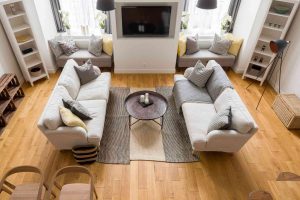 Luxury Vinyl Plank Flooring: LVP flooring has made significant strides in replicating the authentic appearance of hardwood. Advanced printing and embossing technologies enable luxury vinyl planks to mimic the texture and grain of real wood convincingly. With an extensive range of styles and colors, LVP allows homeowners to achieve the look of hardwood without sacrificing practicality.
Luxury Vinyl Plank Flooring: LVP flooring has made significant strides in replicating the authentic appearance of hardwood. Advanced printing and embossing technologies enable luxury vinyl planks to mimic the texture and grain of real wood convincingly. With an extensive range of styles and colors, LVP allows homeowners to achieve the look of hardwood without sacrificing practicality.
- Maintenance:
Hardwood Flooring: Maintaining hardwood floors requires regular sweeping, vacuuming, and occasional polishing. Harsh cleaning agents and excessive moisture should be avoided to prevent damage. Refinishing may be necessary to address scratches and wear, adding to the maintenance effort and cost.
Luxury Vinyl Plank Flooring: One of the key advantages of LVP flooring is its low maintenance. It is resistant to moisture, stains, and scratches, making it easy to clean with a simple sweep or mop. The protective wear layer also contributes to its longevity, reducing the need for refinishing over time. This makes luxury vinyl plank flooring a hassle-free option for busy households.
- Installation:
Hardwood Flooring: Installing hardwood floors can be a complex and time-consuming process. It often involves nailing or gluing individual planks to a subfloor, which may require professional installation. Hardwood is also sensitive to changes in humidity, requiring acclimation before installation.
Luxury Vinyl Plank Flooring: LVP flooring offers various installation options, including click-lock systems, glue-down, or loose lay. The versatility of installation methods makes it a DIY-friendly choice for homeowners. Additionally, luxury vinyl plank flooring is more forgiving in terms of subfloor conditions, making it a quicker and more accessible installation process compared to hardwood.
Conclusion:
In the hardwood vs. luxury vinyl plank flooring showdown, the perfect choice depends on your priorities and lifestyle. Hardwood floors bring a timeless aesthetic to your home but come with higher maintenance and potential durability challenges. On the other hand, luxury vinyl plank flooring offers durability, versatility, and a realistic wood look without the demanding upkeep of hardwood.
Whether you opt for the classic charm of hardwood or the modern practicality of luxury vinyl plank flooring, both options bring their unique charm to your living space. Consider your preferences, lifestyle, and budget to make the best choice for a flooring solution that seamlessly blends beauty and functionality in your home. Still not sure? Connect with one of our team members today!
How Luxury Vinyl Plank Flooring is made
Luxury vinyl plank (LVP) flooring has emerged as a popular choice for homeowners seeking a durable, stylish, and cost-effective flooring solution. Its realistic wood-like appearance, water resistance, and ease of maintenance make it an attractive option. To truly appreciate the qualities of LVP flooring, it's essential to understand the intricate process it undergoes from raw materials to the finished product ready for installation.
The journey of luxury vinyl plank flooring begins with the selection of high-quality raw materials. Manufacturers use a combination of polyvinyl chloride (PVC) resin, plasticizers, and stabilizers. These ingredients play a crucial role in determining the flooring's flexibility, durability, and stability. The careful balance of these components ensures that the final product meets the industry's rigorous standards.
Once the raw materials are gathered, they are thoroughly mixed to create a homogenous blend. This mixture is then heated and formed into sheets, commonly referred to as vinyl sheets or vinyl rolls. The thickness of these sheets can vary depending on the desired characteristics of the final product. Thicker sheets often result in more durable and robust flooring.
The next step in the manufacturing process involves adding a high-resolution photographic layer to the vinyl sheets. This layer is responsible for the realistic wood or stone appearance that has become a hallmark of luxury vinyl plank flooring. Advanced printing technologies are employed to achieve intricate details, such as wood grain patterns and textures, providing a visually appealing and authentic finish.
To enhance the durability and wear resistance of the flooring, a clear wear layer is applied over the printed design. This wear layer is typically made of urethane or other clear coatings that protect the surface from scratches, stains, and daily wear and tear. The thickness of the wear layer varies among different products, with thicker layers offering superior protection and longevity.
 The vinyl sheets, now featuring the printed design and protective wear layer, undergo a process known as embossing. During embossing, the sheets pass through rollers that impart texture onto the surface. This step adds depth and dimension to the flooring, mimicking the feel of natural materials. Whether it's the rugged texture of hardwood or the smooth surface of stone, embossing plays a vital role in enhancing the overall realism of luxury vinyl plank flooring.
The vinyl sheets, now featuring the printed design and protective wear layer, undergo a process known as embossing. During embossing, the sheets pass through rollers that impart texture onto the surface. This step adds depth and dimension to the flooring, mimicking the feel of natural materials. Whether it's the rugged texture of hardwood or the smooth surface of stone, embossing plays a vital role in enhancing the overall realism of luxury vinyl plank flooring.
Following embossing, the vinyl sheets are cut into the familiar plank shapes. The size and dimensions of these planks can vary, providing homeowners with a range of options to suit their preferences and room dimensions. Some planks even feature interlocking systems, allowing for easy, glue-less installation.
The preparation for installation doesn't end with the creation of individual planks. The manufacturing process also involves the addition of an integrated underlayment or backing layer. This layer serves multiple purposes, including sound absorption, thermal insulation, and additional support. The underlayment enhances the overall comfort of walking on the flooring and contributes to a quieter living environment.
As the individual planks are readied for installation, they undergo a thorough quality control process. Manufacturers inspect each plank for consistency in color, pattern, and texture to ensure a seamless and visually appealing floor. Any defective or subpar planks are removed from the production line, guaranteeing that only high-quality products reach consumers.
One notable advantage of luxury vinyl plank flooring is its versatility in installation. Depending on the chosen type—whether it's glue-down, click-lock, or loose lay—the installation process can be relatively straightforward. Click-lock systems, for example, allow planks to seamlessly interlock, eliminating the need for adhesives and facilitating a DIY-friendly installation experience.
Once installed, luxury vinyl plank flooring requires minimal maintenance. Its resistance to water and spills makes cleaning a breeze—typically requiring only regular sweeping or vacuuming to remove dirt and debris. Occasional mopping with a mild detergent solution keeps the floor looking fresh and vibrant.
In conclusion, luxury vinyl plank flooring undergoes a meticulous manufacturing process that transforms raw materials into a resilient, aesthetically pleasing flooring option. From the careful selection and blending of PVC resin to the precision of high-resolution printing and embossing, each step contributes to the creation of planks that closely mimic the look and feel of natural materials. With the added benefits of a protective wear layer and integrated underlayment, luxury vinyl plank flooring is not only visually appealing but also durable and easy to maintain. Whether you're renovating your home or embarking on a new construction project, the journey from production to installation showcases the craftsmanship and technology that make luxury vinyl plank flooring a standout choice in the world of flooring solutions.
Luxury Vinyl Flooring vs Hardwood Flooring: Which is Right for You
When it comes to choosing the perfect flooring for your home, two popular options often come to mind: luxury vinyl flooring and hardwood flooring. Both offer unique benefits and aesthetics, but understanding the key differences can help you make an informed decision. In this blog, we'll explore the pros and cons of luxury vinyl flooring and hardwood flooring to help you determine which one is the right fit for your lifestyle and preferences.
Luxury Vinyl Flooring:
Luxury vinyl flooring has gained immense popularity in recent years, and for good reason. It offers a wide range of styles, patterns, and colors, allowing you to achieve the look of natural materials like wood or stone at a fraction of the cost. Vinyl flooring is highly durable, resistant to scratches and stains, making it an excellent choice for high-traffic areas and households with pets or children. Additionally, its moisture resistance makes it suitable for bathrooms and kitchens. With advancements in technology, luxury vinyl flooring can now mimic the texture and grain patterns of real hardwood, providing a realistic and visually appealing alternative.
Hardwood Flooring:
There's no denying the timeless beauty and elegance of hardwood flooring. It adds warmth and character to any space, and its natural variations make each plank unique. Hardwood flooring is known for its durability and longevity, often lasting for generations when properly maintained. It can be sanded and refinished multiple times, allowing you to refresh its appearance. Hardwood also offers excellent resale value, as it is highly sought after by homebuyers. However, it's important to note that hardwood flooring is susceptible to scratches, dents, and moisture damage. It requires regular maintenance, such as refinishing and occasional resealing, to keep it looking its best.
Factors to consider:
1. Budget: Luxury vinyl flooring is generally more affordable than hardwood flooring, making it a cost-effective option for those on a tight budget.
2. Lifestyle: If you have a busy household with kids and pets, luxury vinyl flooring's durability and resistance to stains and scratches may be more suitable.
3. Aesthetics: If you value the natural beauty and authenticity of hardwood, and are willing to invest in its maintenance, hardwood flooring may be the right choice for you.
4. Moisture Resistance: If you're considering flooring for areas prone to moisture, like bathrooms or kitchens, luxury vinyl flooring's water resistance makes it a practical choice. Hardwood flooring, on the other hand, is more susceptible to water damage and may not be the best option for these areas.
5. Maintenance: LVP requires minimal maintenance. Regular sweeping and occasional mopping are usually sufficient to keep it looking great. Hardwood flooring, on the other hand, requires more attention and care. It may need refinishing and resealing over time to maintain its appearance and protect it from wear and tear.
6. Environmental Impact: If sustainability is a priority for you, hardwood flooring is a more environmentally friendly option. Hardwood is a natural, renewable resource, whereas luxury vinyl flooring is made from synthetic materials. However, it's worth noting that some luxury vinyl flooring options are made from recycled materials, which can help reduce their environmental impact.
In the end, the choice between luxury vinyl flooring and hardwood flooring depends on your specific needs, preferences, and budget. Luxury vinyl flooring offers a wide range of styles, durability, and affordability, making it a practical choice for many homeowners. On the other hand, hardwood flooring provides timeless beauty, authenticity, and the potential for higher resale value. Consider factors such as your lifestyle, desired aesthetics, maintenance requirements, and moisture resistance when making your decision.
Remember, it's always a good idea to consult with our flooring professionals or our visit showroom to see and feel the different options firsthand. We can provide expert advice based on your specific circumstances and guide you towards the flooring that best suits your needs.

